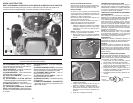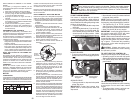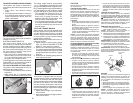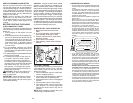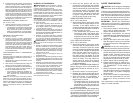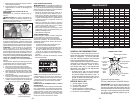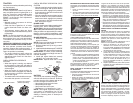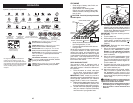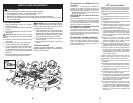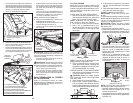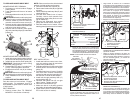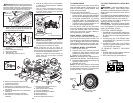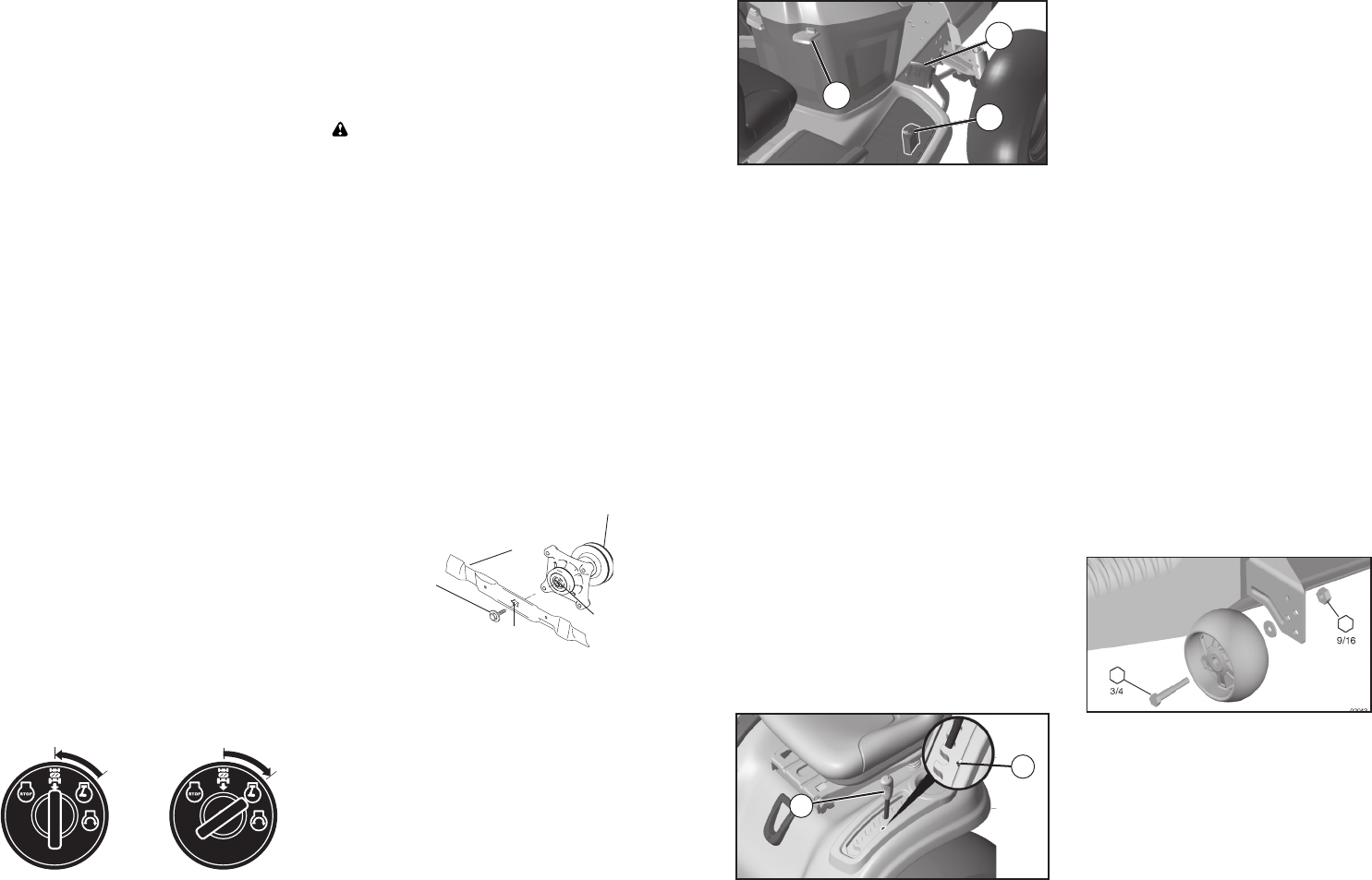
22
BATTERY
Your tractor has a battery charging sys tem
which is suf fi cient for normal use. How ev er,
periodic charging of the bat tery with an au-
tomotive charger will ex tend its life.
• Keep battery and terminals clean.
• Keep battery bolts tight.
• Keep small vent holes open.
• Recharge at 6-10 amperes for 1 hour.
NOTE: The original equipment battery on
your tractor is maintenance free. Do not
attempt to open or remove caps or covers.
Adding or checking level of elec tro lyte is
not necessary.
BLADE REMOVAL
1. Raise mower to highest position to allow
access to blades.
NOTE: Protect your hands with gloves and/
or wrap blade with heavy cloth.
2. Remove blade bolt by turning coun ter-
clock wise.
3. Install new blade with stamped "THIS SIDE
UP" facing deck and mandrel assembly.
IMPORTANT: To ensure proper as sem bly,
center hole in blade must align with star on
mandrel assembly.
4. Install and tighten blade bolt securely
(45-55 Ft. Lbs. torque/62-75 Nm).
IMPORTANT: Special blade bolt is heat
treated.
0
254
5
Blade
Center Hole
Star
Mandrel
Assembly
Blade Bolt
(Special)
TRACTOR
Always observe safety rules when per form ing
any main te nance.
BRAKE OPERATION
If tractor requires more than five (5) feet to
stop at highest speed in high est gear on a
level, dry concrete or paved surface, then
brake must be serviced. (See “TO CHECK
BRAKE” in the Ser vice and Ad just ments
section of this manual).
TIRES
• Maintain proper air pressure in all tires
(See PSI on tires).
• Keep tires free of gasoline, oil, or insect
control chemi cals which can harm rub-
ber.
• Avoid stumps, stones, deep ruts, sharp
objects and other hazards that may cause
tire damage.
NOTE: To seal tire punctures and pre vent
flat tires due to slow leaks, tire sealant may
be purchased from your local parts dealer.
Tire sealant also pre vents tire dry rot and
corrosion.
OPERATOR PRESENCE SYS TEM AND
REVERSE OPERATION SYSTEM (ROS)
Be sure operator presence and reverse
operation sys tems are work ing properly. If
your tractor does not function as described,
repair the problem immediately.
• The engine should not start unless the
brake pedal is fully de pressed, and the
attachment clutch con trol is in the dis en-
gaged position.
CHECK OPERATOR PRESENCE
SYSTEM
• When the engine is running, any attempt
by the op er a tor to leave the seat without
first setting the parking brake should shut
off the engine.
• When the engine is running and the at-
tach ment clutch is engaged, any attempt
by the operator to leave the seat should
shut off the engine.
• The attachment clutch should never oper-
ate unless the operator is in the seat.
CHECK REVERSE OPERATION (ROS)
SYSTEM
• When the engine is running with the ignition
switch in the engine "ON" position and the
at tach ment clutch engaged, any attempt
by the operator to shift into reverse should
shut off the engine.
• When the engine is running with the ignition
switch in the ROS "ON" position and the
at tach ment clutch engaged, any attempt
by the operator to shift into reverse should
NOT shut off the engine.
BLADE CARE
For best results mower blades must be sharp.
Re place worn, bent or damaged blades.
CAUTION: Use only a replacement blade
approved by the manufacturer of your tractor.
Using a blade not approved by the manu-
facturer of your tractor is hazardous, could
damage your tractor and void your warranty.
0
2
8
2
8
ROS "ON" Position
Engine "ON" Position
(Normal Operating)
51
PARA AJUSTAR LAS RUEDAS CALIBRA-
DORAS
Las ruedas calibradoras están bien ajustadas
cuando se encuentran un poco a distancia del
terreno al mismo tiempo que la segadora esté a
la altura de corte deseada. Entonces las ruedas
calibradoras mantienen el conjunto segador en
posición para prevenir el corte raspeo en casi
todos los terrenos.
AVISO: Ajuste las ruedas calibradoras con el
trac tor en una superficie ni ve la da plana.
1. Ajuste la segadora a la altura de corte
deseada con la manilla de ajuste de al-
tura (Vea “PARA AJUSTAR LA ALTURA DE
CORTE DE LA SEGADORA” en la sección
de Operación de este manual).
2. Con la segadora a la altura deseada para la
posición de corte, se tienen que montar las
ruedas calibradoras de modo que queden
un poco sobre el suelo. Instale las ruedas
calibradoras en el agujero adecuado con el
perno con resalto, la arandela de 3/8, y la
tuerca de seguridad de 3/8-16 y apriételos
en forma segura.
3. Repita el procedimiento para el lado opuesto
instalando la rueda calibradora en el mismo
agujero de ajuste.
PARA AJUSTAR LA ALTURA DE CORTE DE
LA SEGADORA
La posición de la palanca elevadora (B) determina
a qué altura se cortará el césped.
• Coloque la palanca elevadora en la ranura de
la altura deseada.
• Deslice el puntero de señalización (T) hasta
esa altura, de modo de recordarla la próxima
vez que corte el césped.
La gama de la altura de corte es de aproxima-
damente 1 a 4 pulgadas. Las alturas se miden
desde el suelo a la punta de la cuchilla cuando
el motor no está funcionando. Estas alturas son
aproximadas y pueden variar dependiendo de las
con di cio nes del suelo, de la altura del césped y
del tipo del césped que se está segando.
• El césped promedio debe cortarse aproxima-
damente a 2-1/2 pulgadas du rante la tempo-
rada fría y sobre 3 pulgadas durante los meses
calurosos. Para obtener un césped más salud-
able y de mejor apariencia, siegue a menudo
y después de un crecimiento moderado.
• Para obtener el mejor rendimiento de corte, el
césped que tiene más de 6 pulgadas de altura
debe segarse dos veces. Haga el prim er corte rel-
ativamente alto; el segundo a la altura deseada.
B
T
MOVERSE HACIA ADELANTE Y HACIA ATRÁS
La dirección y la velocidad de movimientos están
controlados por los pedales de marcha adelante
y atrás.
1. Poner en marcha el tractor y quitar el freno
de mano.
2. Apretar lentamente el pedal marcha adelante
(K) y atrás (L) para iniciar el movimiento. Más
se aprieta el pedal y mayor es la velocidad.
UTILIZAR EL MANDO CRUCERO
El mando crucero se puede utilizar sólo durante
la marcha hacia adelante.
CARACTERÍSTICAS TÉCNICAS
El control de velocidad crucero sólo debe usarse
mientras el tractor esté en labores de siega o
transportación, moviéndose sobre superficies que
estén relativamente planas y rectas.
Otras condiciones de trabajo, como la poda, que
requiere velocidades bajas, podrían desengranar
el control de velocidad crucero. No emplee el
control de velocidad crucero mientras el tractor se
desplaza por elevaciones, terrenos escarpados
o mientras el tractor esté en labores de poda o
virando.
1. Con el pedal (K) de marcha adelante apretado
a la velocidad deseada, mover la palanca de
mando de crucero hacia adelante hasta la
posición “SET” y mantenerla mientras se le-
vanta el pie del pedal, luego soltar la palanca
(J) de mando de crucero.
Para desconectar el mando de crucero, e pujar
la palanca hacia atrás en la posición “OFF”, o
apretar completamente el pedal del freno.
PARA OPERAR LA SEGADORA
Su tractor viene equipada con un interruptor
sen sor que exige la presencia del operador. Si
el motor está funcionando y el em bra gue del ac-
cesorio está enganchado y el operador trata de
bajarse del asiento, se apagará el motor. Tiene
que mantenerse sentado completa y central-
mente en el asiento para impedir que el motor
vacile o se apague cuando se opere su equipo
en terreno disparejo, áspero o en cerros.
J
L
K



